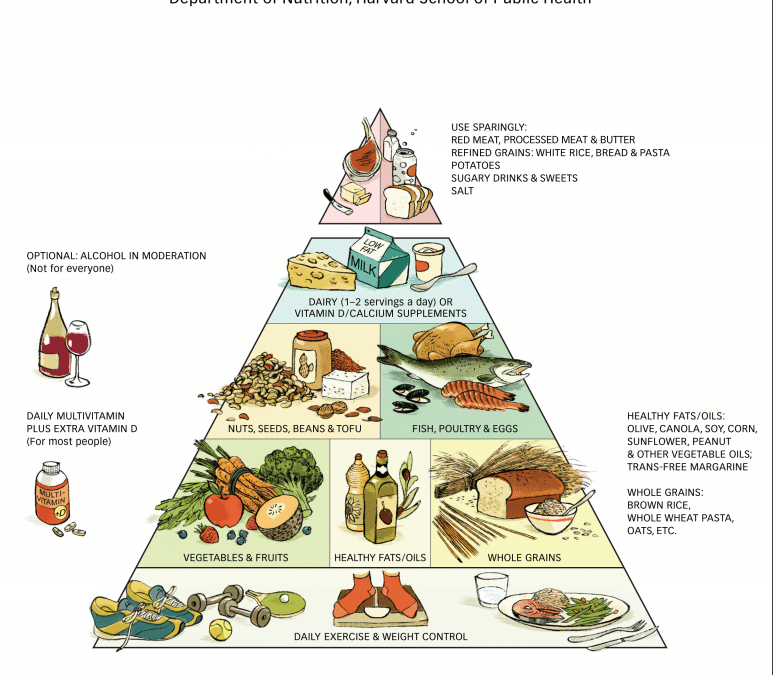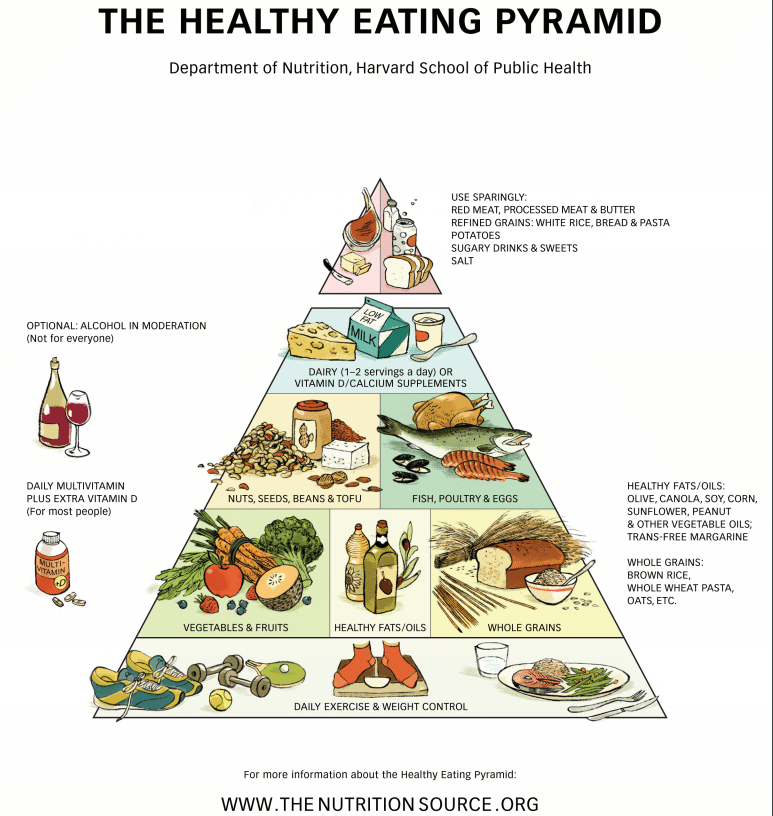Warning: Undefined array key 1 in /var/www/wp-content/plugins/monarch/monarch.php on line 4359
https://www.hsph.harvard.edu/nutritionsource/
Today I have the pleasure of speaking to Dr. Walter Willett. Dr. Willett is the Chairmen of the Department of Nutrition at the Harvard School of Public Health and a Professor of Medicine at the Harvard Medical School. A world renowned researcher Dr. Willett has won many honors including the Mott Prize. He is also an author of Eat, Drink and Be Healthy: The Harvard Medical School guide to healthy eating. In the updated version, Dr. Willett presents healthy eating and a recent revised USDA Heathy Eating Food Pyramid. Thank you for joining us Dr. Willett.
Willett: Good to be with you, thank you.
Glenn: So can you tell us a little bit about what you do?
Willett: Basically, I study the science of epidemiology. It is consequences of what we eat. I look at dietary factors in relations to looking at cardiovascular disease, cancer and more recently, conditions like Parkinson’s disease.
Glenn: Can you explain to our listeners what the science of epidemiology is?
Willett: Epidemiology is the study of the causes and prevention of human disease. It used to be primarily looking at infectious disease outbreaks like malaria or tuberculosis but in today’s world, most people are not dying from infection diseases. So that is what I study.
Dr. Willett Blends Food Science With Epidemiology
Glenn: What was the turning point in your life that made you decide to go down this path?
Willett: I have always been interested in nutrition and food. I grew up in Michigan in an Agricultural background. I was in the 4H club there where in fact, I got awards for my vegetables. When I was in college at Michigan State University, I studied Food Science. From there I went to medical school where I began thinking more about health and disease. That is when I realized it would be very helpful to put these areas together. I did a master’s program at Harvard and did a program in epidemiology and have been working on this since that time.
Glenn: In 2005, the USDA came out with a revised Food Pyramid, however it did not live up to its intended purposes. Some people think it was worse than the original that existed for 13 years. Can you explained why it failed?
Willett: In 1992 the original Food Guide Pyramid was put out. The core idea was that all fat was bad and carbohydrates were good. This encouraged people to load up on carbs. Also, it didn’t make any distinction between eating red meat or fish or beans or nuts or poultry. It lumped them all together in one group and said 2 to 3 servings per day. They had to do something about that and came out with a new pyramid called My Pyramid. That was a series of colored bands. It looked pretty but it didn’t give people clear guides about what foods to limit in their diet and what foods to emphasize. That is why we decided to do this.
Glenn: My understanding is that My Pyramid doesn’t even have any texts or graphs or anything. Is this something you have to get online for to learn more about?
Willett: That’s exactly right. The problem is that many of the people who need to learn about this may not have easy access to the internet. You really have to go out of your way to get that extra information.
Glenn: To my understanding there were still many shortcomings to this revised Food Pyramid as well there. Didn’t they hire the most informed nutritionists in the country to put this thing together?
Willett: By law, they are required to review every 5 years and to come up with guidelines to go with it. I think that is a great law because it recognizes that information is and always can be refined. Foods and food supplies are changing. We are in a dynamic situation. In 2005 there wasn’t the best communications in creating the pyramid itself. The process wasn’t ideal in that people in communications and nutritionists didn’t fully come together and create what could have been created.
Glenn: What I am hearing you say is that the experts didn’t have the final say? Is that correct.
Willett: That’s right.
How Does The Food Pyramid Affect Our Lives
Glenn: In what way does the food pyramid affect our lives in ways we may not be aware of?
Willett: They have some profound effects. But it does fall short on what it could be. Even more importantly, the dietary guidelines are meant to be the basis for all federal food programs. Like food standards for schools, military, and many other organizations who feed people. In some areas, they are being followed very well. Like in the standards for schools. In other areas like SNAP, there are no connections. This is a problem.
Glenn: Are these programs supposed to follow the guidelines?
Willett: I don’t know the exact wording of the laws or regulations, but yes, some of these programs are by law required to be consistent with the national dietary guidelines, in particular, schools.
Glenn: When I look at your food pyramid, I see as the foundation as exercise. What is your recommendation on exercise?
Willett: In general, the more different kinds of exercises you get, the better. But the general guideline is a half hour of moderate to vigorous activity at least 5 days a week as a minimum. But there are advantages to doing more than that. For many people it works well for them to go to a health club or gym, but for a lot of people that doesn’t fit very well in their lives. They may need to build into their life the exercise by walking to school or work.
Glenn: So say you have a job that requires you to do a lot of walking. Does that qualify?
Willett: Walking on the job can certainly fit into that. It should be moderate to brisk walking instead of casually walking. In reality though, there are very few jobs now that require that kind of walking.
Glenn: Can you explain what a good, healthy diet consists of?
Willett: Sure the elements in our pyramid are simple. First of all, healthy forms of fat which would mean minimal animal fats and avoiding trans fats. Healthy forms of carbohydrate meaning, whole grain and high fiber minimizing sugar and refined starches. Healthy sources of protein which means, nuts, legumes, fish, and moderate amount of poultry. Limited amount of red meat. As little as possible of processed meats like bologna and hotdogs. Plenty of fruits and vegetables. Dairy is an interesting topic. On the food pyramid guide, it suggests 3 servings a day. Our research suggests that we don’t really need to have 3 servings a day as adults. One serving a day is fine. Most of the world do not consume dairy on that level and they do not suffer fracture. Having some of that dairy in the form of yogurt is particularly beneficial.
Glenn: Do you address GMO’s? Or is that outside of your research?
Willett: We have not done specific work on GMO’s but, there is no real way to say they are good or they are bad. The main ways that GMO’s have been used in this country is in soybeans to make them tolerate agricultural chemicals. Those changes don’t have direct effects on humans that are good or bad but there are some concerns. There are ways they can be helpful for example by making crops more draught resistant and providing healthy soils.
Glenn: Yes, providing healthy soils. Dr, is there somewhere that our listeners can go to download your pyramid?
Willett: We have our website called Nutrition Source. If you go to google and just put in nutrition source you can easily find it and our pyramid is there along with information about emerging topics on health as well.
Glenn: I for one am really happy so your book out here. You have the years and experience behind it. One day we hear that bananas are good for us, the next day we hear they are not. Who can we listen to and trust on these kinds of things?
Willett: When I started this in the late 70’s, people were being told, don’t eat this or don’t eat that, and there was barely any evidence to support these recommendations. It helped me launch a research project which involved many people showing their own personal information.
Glenn: So are bananas good for you or not?
Willett: If you have a variety of fruits and vegetables it is good for you. So yes, bananas can be a part of that. They do have quite a bit of starch. If someone is on the verge of diabetes and or gaining weight, they are probably not the best food.
Glenn: Artificial sweeteners, and refined sugars should be avoided. Is it ok to use substitutions like honey, maple syrup and raisins on their cereal and what not?
Willett: These other sweeteners like maple syrup and honey would not make a big difference as opposed to straight up table sugar. Raisins would be a bit better because of it coming from the grape.
Glenn: In your book, you mentioned how proper diet can lower birth defects. Can you speak about that?
Willett: Yes, in particular spina bifida. A very common birth defect with women with poor diets. This lead to the identification folic acid as being a protective factor for certain birth defects. We found through a study that woman who took a multi vitamin through the first six weeks of their pregnancy, had a 70% decreased risk of defects in the fetus. Because of that research, since 1998 it’s been required that folic acid be placed in most green products.
Glenn: You mentioned that proper diet and exercise may influence Alzheimer’s disease. Why has Alzheimer’s been so problematic to pinpoint the causes?
Willett: Well we are getting older now as a country. People are living longer now than we did 30 or 40 years ago. So there are more people susceptible now to older related diseases such as Dementia and Alzheimer’s. Also, this has been hard to study because one someone gets this disease you want to ask them about their diet and it is difficult for them to give you an accurate answer. Also, the diagnosis is difficult to diagnose verses breast cancer because it develops over time. There is no specific test you can do either. It’s not until after death that you can do a brain autopsy and check for the characteristics of the disease. It makes it harder to study. The studies for this disease have been short. It is challenging more so than other conditions. There is now though a body of literature building up. Many diet related aspects. Good nutrition is a key point in reducing this disease.
Glenn: Key point here is that you have to challenge the brain and keep it growing and growing.
Willett: Another factor with Alzheimer’s is physical activity. Dementia has been linked to vascular problems. Exercise helps reduce the risks of strokes.
Glenn: What is your take on coffee and alcohol? How do you view that with your pyramid?
Willett: Coffee will reduce the risk of type 2 Diabetes. Good news. Decaf coffee has similar benefits. Also seems to be some small benefit with heart disease as well. Coffee is remarkable safe and has health benefits. It also helps with mood. Suicide rates go down for people who drink three or four cups of coffee per day. Coffee also reduces the risk of gall bladder disease. Alcohol is very complex and interesting. We know that it’s addictive and socially devastating. Also people consume alcohol before driving causing deaths. There have been some benefits with alcohol and heart disease. It seems the benefits shows that a drink a day will have a beneficial impact on heart disease. I should add also, small levels of alcohol will increase breast cancer. Very complex with pluses and minuses. People have to make their own decisions. The benefits don’t become important unless you are someone who has heart issues. If you are 25 and in good health, then it becomes a problem because of the traffic incidents and those kinds of problems.
Glenn: Thank you so much. Any final words of wisdom?
Willett: One of the important findings is that it is never too late to make changes in your diet and lifestyle.
Glenn: Don’t give up, you can always change your life.
Willett: No matter where you are, these choices can make a difference in the quality and length of our life.
Glenn: Dr. Where can our listeners find you?
Willett: Just google nutrition source. And you will get our website. A lot of our work is there. The books you mentioned are available in your local book store. Thinfuence is our new book coming out. It focuses on what we actually put in our mouths. What happens and how it plays out in risk of disease. But also factors that influence our choices. Many factors that have major impact on our food behaviors. Thinfluence again, is the name of the book.
Glenn: Thank you Dr. its been a pleasure.
Willett: Good to talk to you. Take Care.
I’m a self-professed madman, adventurer, photographer, certified High-Performance Coach, martial artist, and licensed physical trainer specializing in senior fitness. My passion is to continue growing and developing into my own unique, gifted, and joyful authenticity, while committing myself towards doing my own special part to help change the world. My mission is to help others find their own direction and purpose in life, by means of mentoring, teaching, and empowering.







